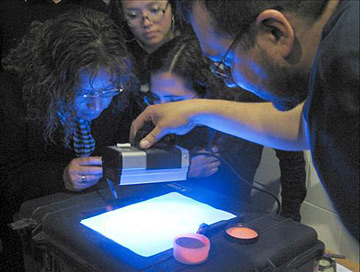
|  |  |  Health & Beauty Health & Beauty  
Crime Wave Fuels Forensics Boom in Mexico
 Chris Hawley - USA Today Chris Hawley - USA Today
go to original
January 13, 2010


| | Instructor Enrique Ramos shows students how to use an ultraviolet light to reveal fingerprints during a class at the International Academy of Forensic Science Training in Mexico City on Jan. 8. (Sergio Solache/USA Today) |  |
Mexico City — Enrique Ramos slipped a long piece of packing tape into a bowl of purple dye, swished it around and then held it up to a light, looking for fingerprints.

"They use this tape for packaging drugs or for tying you up before they put a bullet in your head," he told a group of forensic science students clustered around him. "You get great fingerprints off it."

As Mexico struggles to stem a wave of drug-related crime, forensic science classes such as Ramos' are multiplying, trying to meet the booming demand for fingerprint collectors, crime scene photographers and ballistics experts to keep up with the body count.

"Forensic science is seeing a boom in Mexico," said Rafael Ruíz Mena, secretary-general for professional training at Mexico's National Institute of Criminal Science. "More and more young people are seeing this as a career opportunity."

The growth in forensic science, a highly technical field made popular in the USA with such TV crime series as CSI, comes as Mexico tries to professionalize its police with U.S. aid and as the country embarks on a major overhaul of its court system, creating a need for investigators.

"There's a growing sense that Mexican authorities need to do a better job of investigating, not just writing up police reports," said Amalia Chacon, manager of the Center for Development of Forensic Science Investigations, a school in Mexico City.

It's a major change for Mexican police who have traditionally done little investigative work, rely heavily on confessions and have a history of contaminating crime scenes or posing suspects with weapons in their hands at news conferences, Chacon said.

Last month, a forensic expert, a photographer, a doctor and three other workers from the Morelos state coroner's office were suspended for vandalizing the corpse of drug kingpin Arturo Beltrán Leyva after a shootout with police. The workers allegedly pulled down Beltrán's pants and covered his body with money to make better newspaper pictures.

Since December 2006, when President Felipe Calderón first ordered troops into smuggling hot spots, the number of drug-related murders has soared, from 2,275 in 2007 to 6,587 in 2009, according to a tally conducted by Reforma newspaper.

To combat the violence, the Mexican government has created the Federal Police and pushes officers to improve their investigative skills.

In 2009, the Mexican attorney general's office built a $20 million laboratory building and purchased five mobile crime labs. It has added hundreds of forensic experts in recent years, from 756 in 2003 to 1,425 in 2009. In June, it gave the experts an 18% raise to attract even more.

The U.S. Embassy has donated digital cameras, spectrometers for analyzing chemicals and equipment for detecting false documents and analyzing bullets. In March, U.S. officials will launch three months of classes on forensics and evidence preservation for Mexican police.

Changes to the Mexican legal system are creating a growing demand for independent forensic experts, said Hernán Dinorín, director of the International Academy of Forensic Science Training, another school in Mexico City.

State and federal courts are phasing in U.S.-style "oral trials" to replace the current judicial system, in which trials are conducted through a slow exchange of written briefs.

The change, which began in 2008 and is to be completed by 2016, expands the role of defense lawyers and increases the standards judges must meet to convict suspects.

About 70% of Dinorín's students are lawyers who want to become expert witnesses or learn how to better cross-examine government investigators, he said. Others hope to get into police academies.

"A few years ago, there were maybe two schools offering this kind of education in all of Mexico," he said. "Now it's 30 or 40."

On a recent evening, Dinorín's school bustled with students. In a writing analysis class, students peered through magnifying glasses at photographs of forged signatures. Posters on the wall showed the kinds of ammunition and guns preferred by drug traffickers.

In a darkened classroom, Ramos, an investigator with the federal attorney general's office, cheerfully explained how to cut decomposing skin off a corpse to take its fingerprints.

"You just slip it over your latex gloves, like a second glove," he said as the students cringed.

Viridiana Gaytán, 22, said she was inspired to go into forensics work after watching crimes go unsolved in her neighborhood, a rough area of Mexico City known as Tepito. She wants to work for a state or federal prosecutor's office.

"Where I live, you see all kinds of terrible things," she said. "With this, maybe I can do something for my country — contribute my little grain of sand to the cause."

Hawley is Latin America correspondent for USA TODAY and The Arizona Republic |

 |
|  |



